3 Steps To Get Buy-In For Your Customer Data Platform Project
Getting organizational buy-in for a customer data platform can be challenging. We’ve plotted out a step-by-step guide to help ensure your CDP project sees early and rapid adoption.
Getting organizational buy-in for a customer data platform can be challenging. We’ve plotted out a step-by-step guide to help ensure your CDP project sees early and rapid adoption.
If you’re reading this, it’s likely you’re familiar with the value a customer data platform can bring.
But it’s equally likely not everyone in your organization sees the value of a CDP like you do. Unless you’re able to champion the value a customer data platform can bring to people at all levels of your organization, your CDP project won't even get off the ground, much less take hold or have impact.
In this article, we’ve plotted out a step-by-step guide to help ensure your CDP project sees early and rapid adoption. From documenting requirements, to championing the project at the executive level, this guide will help unlock approval at the right milestones.
Before starting implementation of your CDP project, start by taking take these three actions to understand what success looks like for your organization:
Envision the project outcome.
Map out the requirements.
Create focus with the CDP Value Generation model.
CDP projects often start with people underestimating the work required to capture insightful and reliable data. Instead, they set off without a plan, expecting to piece together answers for their stakeholders afterward.
With such an approach, you might miss essential steps in the process and end up with dots you can't connect.
Form a clear picture of what you want to achieve. Ask why you will collect customer data and what the project will have accomplished when it's delivered.
Abbas Haider Ali, VP of Global Customer and Partner Success at Twilio Segment, encourages you to ask yourself: "What is the headline going to be when this thing is done?" This "working backwards" approach comes from Amazon, where product managers start new projects by writing the final press release instead of specs. The press release becomes a guiding light and helps keep everyone focused on customer benefits throughout the project.
Don't just do this exercise in your head. Write down how you imagine the press release by answering questions like:
What's the headline?
What bullet points sum up the project?
Which numbers are included?
What factors made the project a success?
Send this imaginary press release to other teams, stakeholders, and partners. A shared vision aligns everyone's efforts, a must-have for success.
To detail your path to success, outline your CDP project's existing business and technical requirements. You can do this from either direction, starting from the technical or business side.

An example of a technical requirement informing a CDP project would be creating unified customer profiles for every touchpoint. Another might be enforcing data schema standards across the organization. Even though you can start from technical requirements, these eventually contribute to concrete business goals.
On the other hand, you can also start your project from business requirements. In 90% of cases, you'll measure the ultimate outcome of your CDP project in one or more of these dimensions.
Make money
Save money
Mitigate risk
Further your mission
An example of a business requirement in the “Save money” category would be increasing the ROI of existing advertising spend by the marketing team, allowing for a reduction on overall spend while preserving revenue targets. In order to achieve this, it would lead you down the path of building a 360-view of the customer that better informs where a customer is in their journey allowing for more targeted campaigns to be run.
Whether you start from a business or technical point of view, it’s important to note that a CDP project needs input from both directions. Imbalance in either direction is a primary cause of misalignment and has the potential to sink your project before you’re out of the gate.
In our examples above, taking just the business requirements into consideration, we would miss out on technical requirements for data schema standards in selecting a CDP. And taking just the technical requirements into account wouldn’t direct our unified profiles into audiences and journeys that are activated through paid marketing channels.
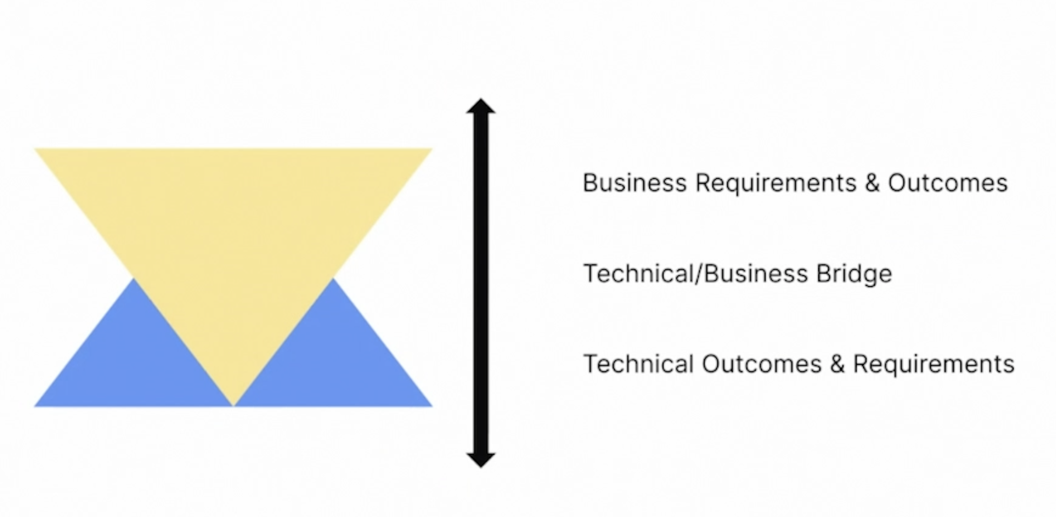
So, you have a clear vision – your “press release” – and a list of requirements. Put these pieces together in more detail using the CDP Value Generation model.
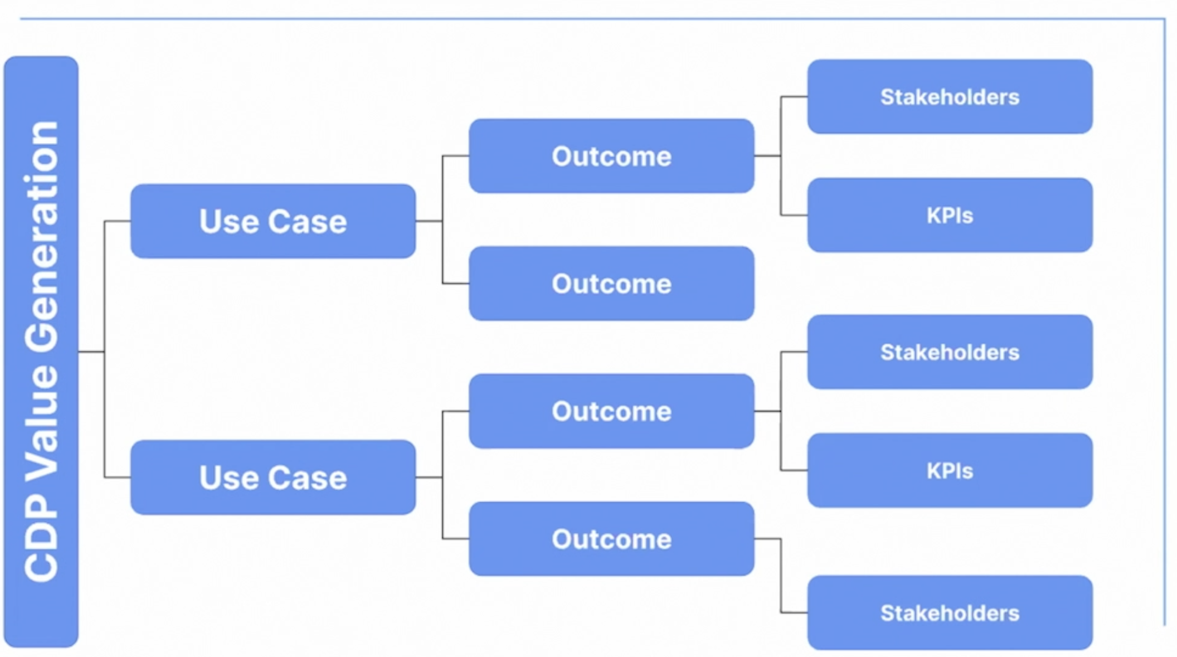
The framework brings together use cases, outcomes, stakeholders, and measurements (KPIs) in one overview:
Use cases: What are you trying to do and for whom?
Outcomes: What's the desired outcome of each use case?
Stakeholders: Who has an interest in that outcome?
KPIs: Which metric validates if you've achieved your outcome? (Optional, as not everything is quantifiable.)
Here's a sample model in action, used to plan Segment's data collection for our annual event, CDP Week:
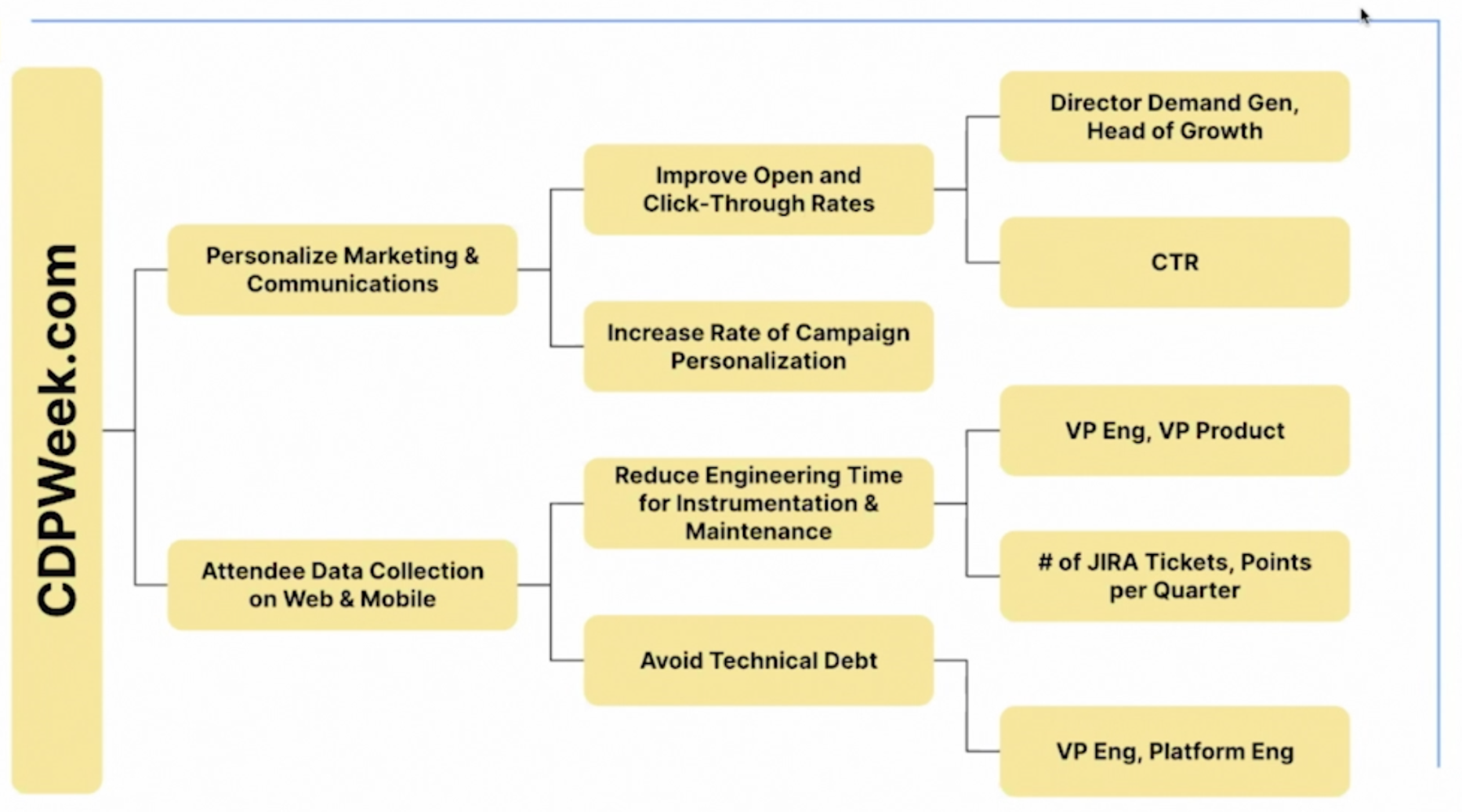
The first use case is a business requirement to personalize marketing and communications around the event. It has two outcomes, one of which is to "Improve open and click-through rates." Stakeholders are the Director of Demand Generation and Head of Growth with CTR as the primary KPI.
The second use case is a technical requirement to collect data on attendees' mobile devices and the web. One of its outcomes is to "Reduce engineering time on instrumentation and maintenance," the other is to "Avoid technical debt."
Both outcomes have VPs of Engineering and Product as stakeholders, and we measure the first one through the number of JIRA tickets.
The CDP Value Generation model gives you a map of your project outcomes that you can share with stakeholders. It helps everyone stay focused throughout the project, getting you to time to value quickly.
Whatever your vision, at the end of every successful CDP project awaits streams of valuable data. Standards get you there.
Seth Familian, Director of Global Advisory Services at Twilio Segment, puts it this way: "Behind every piece of good data is a great person who adopted a great standard."
Setting standards requires a team with the right people. So before you move to implementation, you need to do the following:
Set your data standards.
Recruit people to uphold your standards.
Decide and align on ownership.
Setting standards is straightforward. All data attributes need to be consistent — in capitalization, spacing, and data type — across platforms, business units, and geography.

Standards result in useful data that:
Reduces time spent on tedious extracting, transforming, and loading (ETL) to clean up bad data.
Enables understandable reports, trusted from the bottom to the top of the org chart.
Facilitates accurate automation and audience building for your marketing and product teams.
Delivers a higher ROI on advertising spend with every audience you build.
Maintaining standards is the real challenge, which is why you need the right people.
Adopt a standard for every event and property you track, and the outcome is good data. To successfully deliver your CDP project, you need stakeholders who do this across your organization and help evolve the standards as your CDP matures.
Pulling this off requires an orchestration of people far beyond the engineering department. You need to have decision-makers on board who can champion the project at the executive level, provide access to crucial information, and unlock approval at the right milestones.
These are the essential roles for a CDP project:
Project Champion: The executive sponsor, owns project escalations.
Business Owner: Articulates business goals, KPIs, and use cases.
Technical Owner: Understands the current technical architecture at your organization and allocates technical resources like engineers and data scientists.
Marketing Owner: Defines campaign requirements and owns the downstream activation tools where you use customer data.
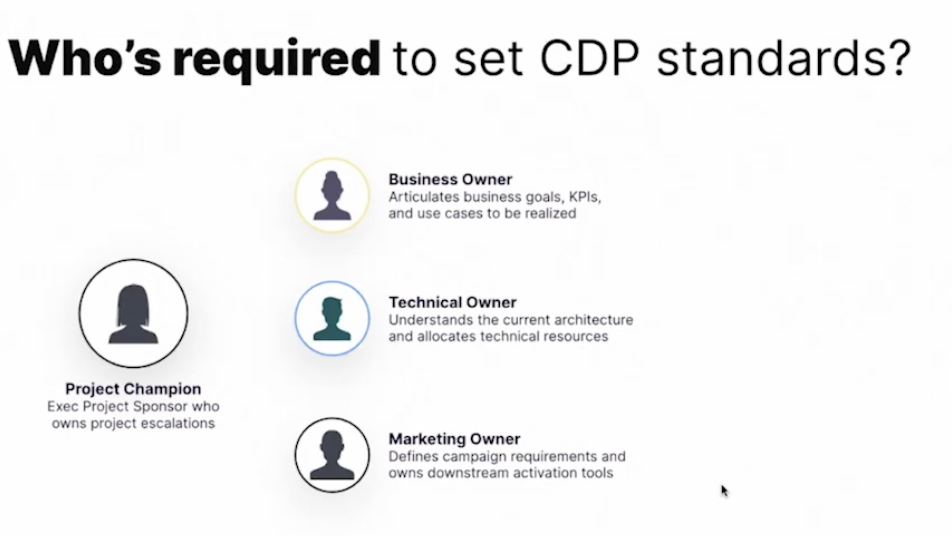
The number of people involved can change for every project, but the roles do not. The Project Champion might also be the Business Owner at a smaller company, whereas they're two different people at a larger one.
One common mistake at smaller startups is to ignore the marketing role while everyone is busy with technical implementation. Avoid this mistake by covering every role at the start of your project, even if several people on a small team will wear multiple hats.
Depending on your organization's size and the CDP project's scope, there can be many more roles reporting to the core ones we just covered. As Seth Familian likes to say, "It takes a village to standardize a CDP!"
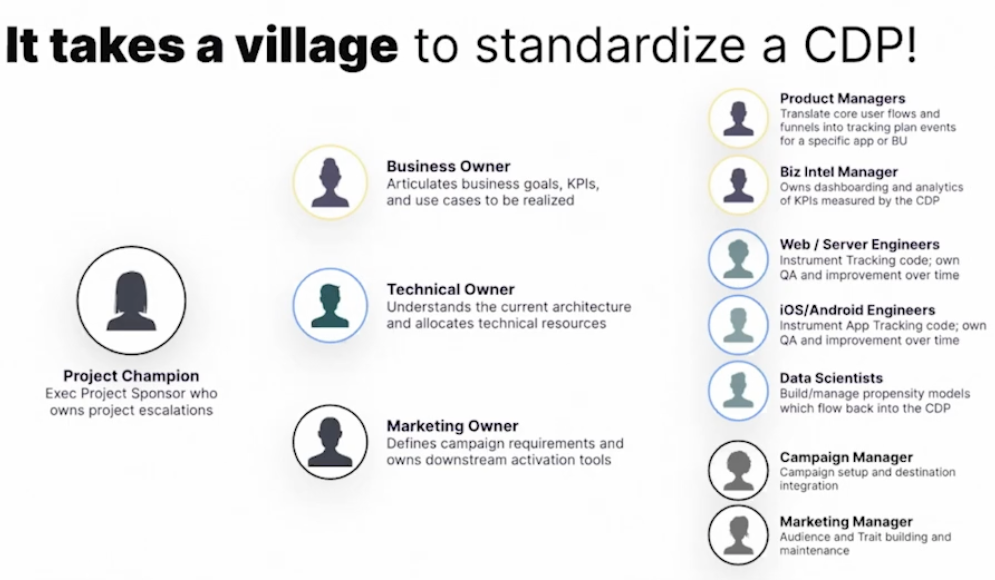
The roles reporting to a Business Manager could include:
Product managers: Help unify all the event measurement standards so you can look at the same funnel metrics across products.
Business intelligence managers: Create dashboards for your CDP’s business goals and KPIs identified earlier.
The roles reporting to a Technical Owner include:
Engineers (web, server, mobile): Implement Segment tracks and identify calls (page and group) within various properties, like apps and the web.
Data Scientists: Help the Technical Owner understand how to optimize the data on the backend.
The roles reporting to a Marketing Owner include:
Campaign Manager: Sets up activation tools and manages destination migration. Also ensures events get delivered correctly and engagement activities run end to end.
Marketing Manager: Builds audiences and traits in Segment for the Campaign Manager – essentially sets the standard for whom to target.
You can choose from two ownership models for your data standard:
Wrangler: One taskmaster owns the standard across the entire CDP project.
Champions: You distribute ownership by cultivating product managers and engineers who adopt the standard and proliferate it throughout their teams.
Let your organization's culture inform what works best for you. If top-down decision-making is common, a wrangler might work best. If teams work more autonomously in a transparent environment, the champions model is suitable.
Before moving to implementation, make sure everyone understands which ownership model you've chosen and their roles and responsibilities.
From working through thousands of CDP implementations, Segment has developed a step-by-step methodology for delivering CDP projects:
Readiness
Discovery
Planning
Implementation
Review
Ongoing
With these steps, you'll be ready to hit your desired outcomes and create widespread adoption of the CDP across your organization.
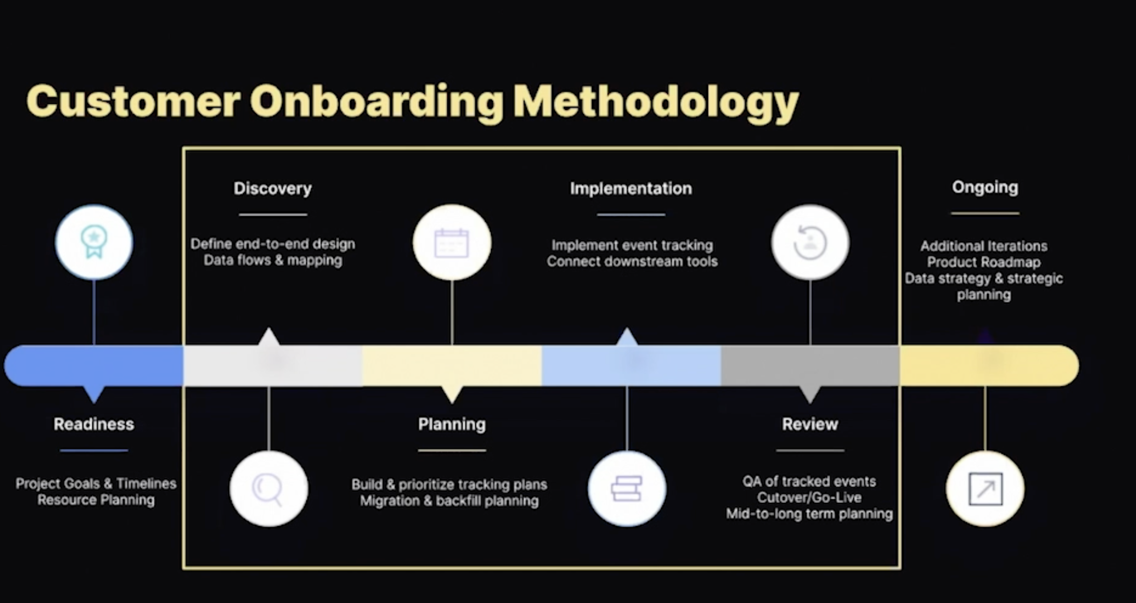
Prepare your project using the elements we discussed in the previous chapters — envisioning your project outcome, setting standards, and bringing the right people on board.
This is also the time to plan and establish timelines for your project together with your stakeholders.
Activities
Envision project outcome
Set data standards
Recruit your team
Plan timelines.
Define what the end-to-end solution will look like. You connect the goals and use cases from Readiness to the activities necessary to deliver the data. Make sure this includes an inventory of where data will come from and where it needs to go.
Say you have a business goal to acquire new users on a mobile app. You want to acquire these users via paid ads on social media and Google, and then engage and activate those new users using a tool like Braze. On top of that, you want to assess drop-off patterns to improve the user experience with Amplitude.
This is the level of detail you need during Discovery to design and map data flows for all the different tools you’re connecting to Segment. You'll end up with a clear overview of data sources and destinations for the project.
Activities
Define end-to-end design
Data flows and mapping
Now, work on the specifics of the CDP implementation with:
Tracking plans
Prioritization decisions
Migration planning
If you’re new to the world of tracking plans, here's a quick primer:
“A tracking plan is a document or spreadsheet used across an organization to standardize how it tracks data. Often serving as both a project management tool and a reference document, a tracking plan aligns multiple teams around one strategy for customer data collection.
Essentially, a tracking plan consists of a list of events (i.e., user actions) accompanied by a description for each event.”
You use the tracking plan to connect all elements from previous phases—business outcomes, use cases, data flow diagrams—to specific data points. It's your implementation's backbone as you'll soon hand over this plan to your engineers to start their work.
You also need to think about prioritization during planning, with questions like:
Which platform or tool is most important for our business outcomes?
Is there a particular tool that can quickly deliver value if we get the data in there first?
By asking these questions before implementation starts, you'll know which tasks to work on first to deliver quick wins and accelerate time to value.
Finally, complete migration planning. Identify data points you're already collecting with existing implementations, which you're now going to reroute to Segment.
You might also have existing data sitting in systems that you want to backfill into Segment. Understand what that data looks like, how it exists in your systems today, and how you're going to bring that into your new CDP.
Activities
Build and prioritize tracking plans
Prioritization decisions
Migration and backfill planning
Showtime! The engineers receive your plans from the previous phase and get to work. They'll set up downstream tools, and data starts flowing through them.
If a migration is involved, this is when you'll port over that data. You'll also be doing the backfill and see Segment welcoming its first data from your CDP project.
Activities
Implement event tracking
Connect downstream tools
Migration and backfill
Check the end-to-end implementation, and validate if everything is working. Your Segment workspace has first-class tooling available to support your quality assurance (QA) activities in this phase.
You'll cut over from your original setup to your new CDP implementation now.
Activities
Validation (end-to-end)
QA of tracked events
Cut-over and go live
Note, there are some ongoing responsibilities — maintenance, iterating, and long-term planning — to ensure long-term success with a CDP.
Championing a CDP project will look different depending on the specific needs of your organization, but no matter your requirements there are three principles worth remembering as you adopt a CDP.
Win hearts and minds by emphasizing how the new technology benefits the organization and makes employees’ lives easier
Encourage adoption by rewarding employees in ways that are most meaningful to them.
Build the new technology into the routines and rhythms of the workday as soon as possible.
Ultimately, a CDP exists to deliver value to your customers and business. Follow our process, and you'll achieve CDP project success fast and reliably. Plus, you’ll set yourself up for continuous gains by working towards CDP maturity.

Our annual look at how attitudes, preferences, and experiences with personalization have evolved over the past year.